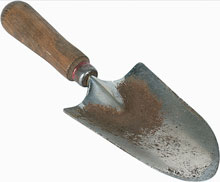 Environmental researchers testing the city’s soil for lead are finding that not all is well beneath May’s bursting blooms: some properties are contaminated by as much as three times the “acceptable” level of the heavy-metal contaminant.
Environmental researchers testing the city’s soil for lead are finding that not all is well beneath May’s bursting blooms: some properties are contaminated by as much as three times the “acceptable” level of the heavy-metal contaminant.
About 70 Munjoy Hill properties were recently tested as part of one project, a partnership between the city of Portland, the University of Southern Maine, and the Maine Department of Environmental Protection.
The East End is the third Portland neighborhood to be tested — soil testing has already occurred in the West End and Bayside areas, where researchers discovered high lead levels.
According to the DEP, the highest acceptable concentration of lead in soil is 375 parts per million (ppm). But tested properties have levels as high in some cases as 1000 ppm, according to Samantha Langley-Turnbaugh of the USM department of environmental science.
As of press time, test results from Munjoy Hill were incomplete, but are expected to be in line with the results from the previous testing elsewhere.
“We are starting to send out some of those findings to property owners as they come in,” said Lisa Belanger of Portland’s health and human services department. “If it is similar to other neighborhoods we have tested we will not be surprised to find a considerable lead burden.”
So what does this mean for the earthy residents of one of Portland’s greenest neighborhoods?
First, the community’s celebrated gardens are at stake — toxic levels of lead contaminate fruits and vegetables. While it would take years of steady consumption to affect an adult, children are particularly vulnerable to the ingestion of toxins.
Even small amounts of lead can cause behavioral problems and learning disabilities in children, and lead poisoning interferes with the development of a child’s nervous system. Because concerned residents were so numerous, the study’s organizers limited tests to homes of the most at-risk group, children under the age of five.
Belanger says the city plans to organize a neighborhood meeting for concerned Munjoy Hill residents to discuss the final results and “relatively low cost means” to ensure the safety of the community. The meeting has not yet been scheduled.
“People should be aware of [the high lead levels] to take steps to limit their exposure,” said Langley-Turnbaugh. “It’s an educational effort.”
While ground covers and grass can be used as protective measures, those leading the study are most excited about using phytoremediation. The process removes detrimental agents like lead and arsenic naturally and efficiently with plants. Spinach is especially effective, absorbing up to 100 ppm of a contaminant over a planting season.
The USM research team plans to establish three or four phytoremediation spinach gardens in Munjoy Hill. After the spinach is harvested, the soil will be re-tested to gauge improvement.
“[Phytoremediation] has been an effective means of removing lead from soil, depending on the lead burden,” said Belanger. “It doesn’t mean that you’ll remove all the lead from the soil but it is a means we are exploring.”
Our advice to East End residents: don’t eat the spinach.